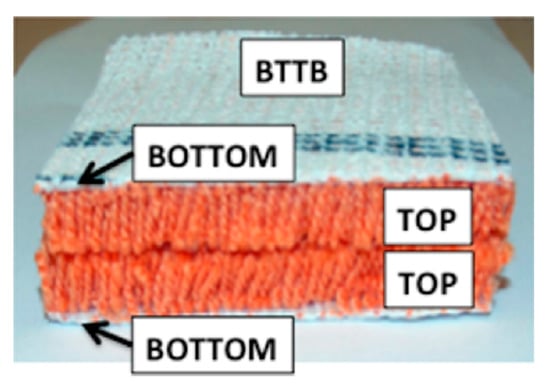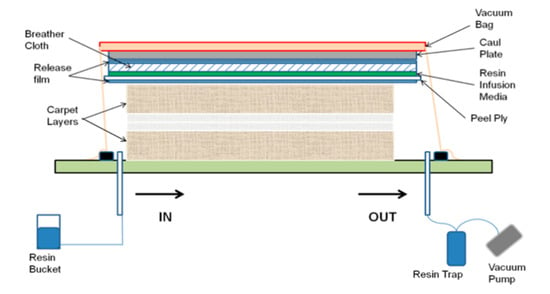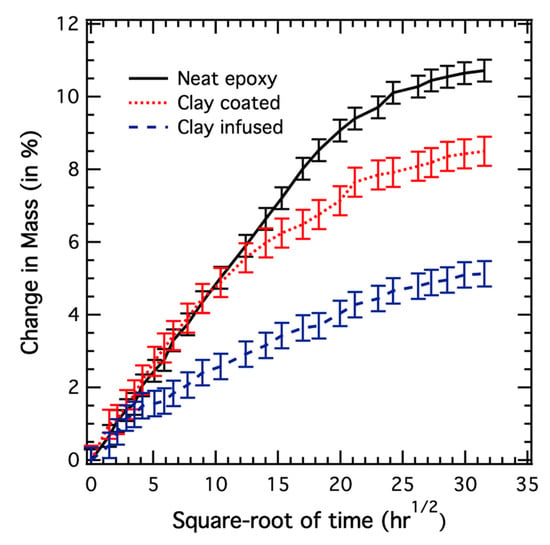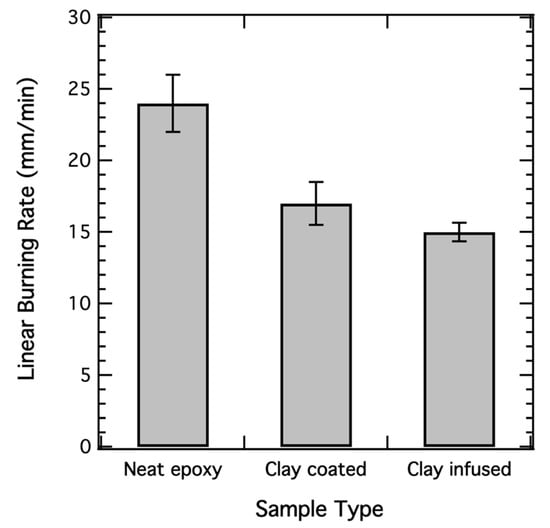Abstract
In the present study, we recycled waste carpet using a vacuum-assisted resin transfer molding (VARTM) process. Three different variations of carpet composites were fabricated, namely, neat epoxy, clay-coated, and clay-infused carpet composites. The carpet composite samples were degraded hygrothermally as well as under a cyclic UV condensation condition. Presence of clay was shown to impede the moisture absorption and UV degradation in the carpet composites. Flexural properties also showed that the presence of clay slows the degradation process of the composites. The flame retardancy result indicated that the presence of clay in the polymer network decreases the ignition time of the carpet composites.
1. Introduction
Carpet waste is both an environmental and economic problem because of the costs involved in the disposal of waste carpet. The costs also consist of discarding of valuable raw materials like Nylon 66, polyester, polyvinyl chloride (PVC), polypropylene (PP), other olefins, etc. which go to landfills as well as the cost of transporting the waste to landfills. The presence, of used post-consumer carpet material at the landfilling is causing several environmental issues because the carpet fibers are non-biodegradable. Therefore, recycling of carpet as a structural composite serves as a motivation to address the problem of recycling waste carpet [1,2,3,4].
The recycling process of carpet has been minimal due to different material components and accumulation of various contaminants. Recycling can be done either by depolymerization, separation of a part, melt blending, or energy recovery. However, these recycling techniques are pervasive, time-consuming, and economically infeasible. This results in limited recycling, and therefore improvement in the recycling process is required [1,2].
Recently, several studies have been done on the recycling of the waste carpet into the structural composites using the vacuum-assisted resin transfer molding (VARTM) technique [4,5]. The main advantage of this recycling process is that it does not require any physical or chemical treatment of the carpet, and the process uses as-received carpet.
As a result, it eliminates the energy and cost barriers of the traditional recycling processes. These composites can be used as the structural component for highway sound barriers [4] and tooling composites [5]. Carpet composite has shown high sound absorption properties as compared with conventional highway barriers. However, during long-term outdoor applications, the composite panels are exposed to UV, moisture, heat, wind, dust and other pollutants that could potentially deteriorate the properties of the composite panels [6,7,8,9,10,11,12]. Epoxy and the nylon fiber have shown to be significantly affected by moisture absorption [13,14,15]. The application of nanoclay, however, have shown a reduction in the moisture absorption rate while maintaining the mechanical integrity of the material [16,17,18,19,20,21,22]. Polymers are more vulnerable than metal, ceramic, or concrete as a construction material because of their flammability. The polymer can start a flame once the surface temperature reaches the ignition point. Nanoclay is also used as a fire retardant material for polymers due to either the barrier effect or the formation of char [23,24,25,26,27]. The network structure formed by nanoparticles creates a thermal shield for heat, oxygen, and other combustible products and reduces the supply of fuel for the flame.
The primary objective of this study is to understand the influence of clay present in mechanical, environmental, and flammability properties of the recycled carpet composite fabricated by the VARTM process.
2. Experimental
2.1. Materials
The resin system used for this study was System 2000 epoxy purchased from FibreGlast Corporation (Brookville, IN, USA), which is a diglycidyl ether bisphenol A (DGEBA-) based resin, mixed with 2120 epoxy (primary amine-based) hardener at the ratio of 100:27 (epoxy:hardener). The mixture had a medium viscosity of 925–975 cps and a 2-h pot life at room temperature.
The nanoclay used in this study was Nanomer I.28 (Nanocor, Inc., Hoffman Estates, IL, USA). This nanoclay had been selected because of its affinity with the epoxy resin, and also because of the long chain length of clay, since a chain length of 28 clay as the modifier helps with better dispersion and higher mechanical strength of the nanocomposites than clay modified with a shorter chain.
In this study, a nylon cut and loop type carpet called Orange Cool Aid by Shaw Industries (Atlanta, GA, USA) was selected.
2.2. Fabrication of Carpet Composites
For this study, only BTTB (bottom-top-top-bottom) configurations have been used as shown in Figure 1. The following three different types of carpet composites were fabricated for this study: (a) neat epoxy carpet composite, (b) clay-coated carpet composite, and (c) clay-infused carpet composite.

Figure 1.
Configuration of carpet preform for fabrication of composite.
The vacuum-assisted resin transfer molding (VARTM) process was used to fabricate carpet composites, as shown in Figure 2. In this process, layers of carpet were placed on a metal mold which was completely sealed inside a vacuum bag with an inlet and outlet port for the resin to flow through the carpet layers. A vacuum pressure of 75 kPa was utilized to pull the resin and infuse inside the carpet layer.

Figure 2.
Schematic diagram of the mold for the VARTM process.
To fabricate clay-coated composite, first, epoxy resin and clay at the weight ratio of 100:4 clay were mixed by magnetic stirring for 24 h at 120 °C following the addition of the hardener. The clay mixture was coated by a paint roller on neat epoxy carpet composite.
After coating, the coated material was cured at room temperature for 24 h followed by post-curing at 121 °C for 6 h. To fabricate the clay-infused carpet composites, 4 wt% of clay was dispersed in the epoxy by magnetic stirring for 24 h at 120 °C, and the clay-epoxy mixture was infused through the carpet layers by the VARTM process. The resin was pre-cured for 24 h at room temperature, and then, post-cured at 121 °C for 6 h.
2.3. Moisture and UV Exposure
In order to understand the effect of hygrothermal degradation in carpet composites, the samples were submerged in sub-boiling deionized water for 1000 h. A bulb condenser was attached on the hood of the water vessel to prevent water evaporation and to maintain a constant water level. Maintaining the same water level helped to keep the temperature steady. Edges of the specimens were coated with high-temperature wax to ensure unidirectional water diffusion. Before submerging the samples, the temperature of the water was kept around 80 °C by controlling the hot plate temperature. To reduce evaporation loss during the weight measurements, samples were placed in room temperature water for 10 min to bring them to ambient temperature before weight measurement. Before every analysis, the specimen surface was wiped carefully to remove the surface water.
We also investigated the combined effect of UV and condensation by exposing several composite samples to alternating cycles of 8 h of UV radiation and 4 h of water vapor condensation [27]. The prepared 65 × 65 mm composite plate was exposed. For the first cycle, an irradiance of 0.89 W/m2 at 50 °C was applied, and for the second cycle condensed air was applied at 50 °C for 4 h using QUV/SE accelerated weathering tester (Q-Panel Lab Products, Cleveland, OH, USA) after every 2 cycles (24 h). High-temperature wax was applied on the edge of the composite to ensure unidirectional moisture diffusion.
2.4. Characterization of Mechanical Properties
Flexural strength and modulus were determined using the three-point bending test according to the ASTM D 790 standard [28]. The samples were cut as per the ASTM standard from prepared carpet composite plate. For this test, a Universal testing machine (Instron 5567, Norwood, MA, USA) was used with an adjustable anvil, two support anvils with a radius of 4 mm and a loading anvil with a 10-mm radius. A total of 10 samples per set was used to obtain the scatter in results.
2.5. Flammability Characterization
The flammability resistance of the carpet composite was determined as per the ASTM D 635-10 standard [29] as shown in Figure 3. A composite bar of 125 mm length was placed horizontally, and the free end of the samples was exposed to a standard test flame for 30 s, and then a flame was removed. The time of the flame propagation between two fixed positions of the composite bar at a 75 mm distance was recorded. At the recorded time the flame propagation rate was measured in mm/min unit. An average of 10 samples was reported for each type of composite.

Figure 3.
Test setup for determining flame propagation rate.
3. Results and Discussion
3.1. Gravimetric Analysis
Figure 4 represents the comparison of moisture absorption behavior in different carpet composites. As observed from the graph, after 1000 h, the neat epoxy composite has reached saturation. However, for clay contained composites, the moisture absorption is reduced. The relative amount of moisture for the neat epoxy composites was about 11%, whereas, for clay-coated and clay-infused samples, it was around 8% and 5%, respectively. This reduction in the moisture absorption due to the infusion and coating of clay is because of the barrier properties provided by the clay due to the clay-stacked structure. The maximum moisture absorption for epoxy and nylon are reported as 7% and 9%, respectively [23,24] which suggests that neat carpet composite absorbs more moisture than the individual components.

Figure 4.
Moisture absorption behaviors of different carpet composites at 80 °C.
The change in the mass of the carpet composites due to moisture absorption as a function of the square root of time is shown in Figure 5. In the plot, the initial straight line indicates one directional Fickian diffusion, which suggests that the movement of the moisture molecule is through micropores only [30,31]. The composite prepared by only neat resin shows the highest increase in the mass with time as compared with the clay-coated and clay-infused composites. This increase in the mass for the neat resin is due to the higher moisture absorption, as shown in Figure 4. The mass change for the composite prepared by clay infusion is less as compared with neat resin and clay-coated composites. The result indicates that the barrier properties of clay in the resin restrict the absorption of moisture in the composites.

Figure 5.
Change in mass in carpet composites as a function of the square root of time.
Interestingly, composites prepared by clay coating initially show the rate of increase in mass similar to the neat resin, however, with an increase in time, the rate of change in mass decreases for the clay-coated composites. This decrease in the moisture absorption rate with an increase in exposure time is because the saturation on the surface is reached more quickly for clay-coated composite than neat resin composite. After saturation is reached on the surface, the clay restricts further moisture absorption.
For the cyclic exposure of UV and condensation as shown in Figure 6, we observed a similar trend in the change of mass in carpet composites, as neat resin gained more mass than either clay-infused or clay-coated carpet composites. The phenomena behind the mass change for cyclic exposure of UV and condensation is similar to the hygrothermal condition where clay either acts as a barrier for moisture absorption by providing the tortuous path.

Figure 6.
Change in the mass of carpet composites due to alternating environmental exposure.
3.2. Mechanical Properties
Table 1 summarizes the flexural strength of carpet composites before and after moisture absorption. The obtained flexural strength value of neat resin and clay-coated composites shows a similar value. The result suggests that the thin clay layer coating did not show any effect in the flexural strength. However, for the clay-infused samples, around 13% increase in flexural strength was observed as compared with the neat epoxy composite. Previously, researchers have also shown a similar result with the clay inclusion. The improvement in flexural strength for clay-infused carpet composites is attributed to the enhancement of strength in the epoxy matrix and the interfacial interaction of fibers and clay [32,33].

Table 1.
Flexural strength of carpet composites.
In comparison with the as-prepared samples, a significant reduction of flexural strength of the composites has been noticed after the moisture absorption. For the neat epoxy composite, clay-coated composite, and clay-infused composites the observed reduction in flexural strength was 22.7%, 18.7%, and 15.7%, respectively. Reduction in flexural strength can be due to chemical degradation of both the fiber and epoxy matrix, and due to the decrease in interfacial bonding between the fibers and epoxy. The minimum reduction of flexural strength was in the clay-infused composite. It can be assumed that the higher barrier property of the clay-epoxy matrix against water slowed down the degradation process of the nylon and the fiber-matrix interface. At the same time, the presence of clay in the epoxy matrix maintained better mechanical properties of the epoxy matrix after the degradation process.
For the cyclic exposure of UV condensation, the results show an unexpected increase in flexural strength. The possible explanation for this could be an increase in the cross-linking density in the epoxy matrix due to the high temperature in the degradation chamber [34,35]. UV degradation are surface phenomena and due to the thicker carpet composite sample the 1000 h exposure time is not enough to significantly change the mechanical properties as a result of degradation. Similar behavior was explained by Liau et al. [16].
Table 2 shows the flexural modulus of different carpet composites before and after moisture absorption. The prepared clay-infused composites demonstrate a 40.8% increase in flexural modulus as compared with the neat epoxy samples. The increase in the flexural modulus is due to the presence of the stiffer clay material. Another possible explanation for the modulus enhancement could be the increase in interfacial bonding between matrix and fiber by clay platelets.

Table 2.
Flexural modulus of carpet composites.
Reduction in elastic modulus due to moisture absorption is observed in carpet composites. This decrease in the modulus is directly related to the scission of the polymer chain. For the neat epoxy, clay-coated, and clay-infused carpet composites the reduction was 51.2%, 41.1%, and 46.3%, respectively.
The neat, clay-coated, and clay-infused carpet composites show an increase in flexural modulus after alternating UV condensation exposure. This may be due to the increase in crosslink density due to the UV exposure that resulted in restricted molecular movements.
3.3. Flame Retardancy Properties
Figure 7 shows the comparison of the linear flame propagation rate for carpet composites. A 20% and 34% reduction in the average linear burning rate for clay-coated and clay-infused samples, respectively, are observed as compared with the neat composites.

Figure 7.
Linear burning rate of neat and clay carpet composites. The error bar shows ± standard deviation of eleven specimens.
The clay-coated samples have clay film only on the surface, and it can be assumed that clay film delayed the ignition time to initiate the flame propagation. The formation of the initial flame is important in flame propagation in the absence of any other external heat source [36]. Delayed ignition time can be attributed to the thermal stability increase provided by nanoclay. The lowest flame propagation rate is observed in the clay-infused composite which indicates that the presence of clay platelets throughout the matrix reduces the flame propagation. The result is following the reported observation of a reduction in flammability of clay polymers as compared with neat polymers. Nanoparticles, like clay, when present in the polymer matrix help by forming a network-like structure against the decomposed flammable product and impede the burning process.
4. Conclusions
The waste carpet was recycled using VARTM into structural composites. Three different configurations of the carpet composite were fabricated, for example, neat epoxy carpet composite, clay-coated carpet composite, and clay-infused carpet composite. The prepared carpet composites were subjected to a hygrothermal condition as well as cyclic UV and condensation exposure. The clay-infused carpet composite showed less variability in mass increase due to the barrier effect of clay in the polymer network. A similar trend was observed in the flexural properties of carpet composite where the clay-infused carpet composite showed the best result for as-is moisture degraded and cyclic UV condensation exposed samples. The presence of clay in the epoxy resin also increases the flame-retardant behavior of the carpet composites.
Author Contributions
K.M. works in methodology, conceptualization and writing original draft. R.V. worked on validation, resource and writing-review.
Funding
The authors would like to thank the Oklahoma Center for Advancement of Science and Technology (OCAST) for funding this project under project number OARS AR09.1-055 “Structural Materials from Recycled Carpet”, and the Oklahoma Transportation Center under project number OTCREOS9.1049, “Recycle carpet materials for infrastructure applications.”
Conflicts of Interest
The author declares no conflict of interest
References
- Mihut, C.; Captain, D.K.; Gadala Maria, F.; Amiridis, M.D. Review: Recycling of nylon from carpet waste. Polym. Eng. Sci. 2001, 41, 1457–1470. [Google Scholar] [CrossRef]
- Young, D.C.; Chlystek, S.J.; Malloy, R.; Rios, I.; Lear Corporation. Recycling of carpet scrap. US Patent 5,859,071, 1999. [Google Scholar]
- Al-Salem, S.; Lettieri, P.; Baeyens, J. Recycling and recovery routes of plastic solid waste (PSW): A review. Waste Manag. 2009, 29, 2625–2643. [Google Scholar] [CrossRef] [PubMed]
- Mishra, K.; Vaidyanathan, R.K. Application of Recycled Carpet Composite as a potential Noise Barrier in Infrastructure Applications. Recycling 2019, 4, 9. [Google Scholar] [CrossRef]
- Mishra, K.; Das, S.; Vaidyanathan, R. The Use of Recycled Carpet in Low-Cost Composite Tooling Materials. Recycling 2019, 4, 12. [Google Scholar] [CrossRef]
- Davis, A.; Sims, D. Weathering of Polymers; Springer, Science & Business Media: Essex, UK, 1983. [Google Scholar]
- Abeysinghe, H.; Edwards, W.; Pritchard, G.; Swampillai, G. Degradation of crosslinked resins in water and electrolyte solutions. Polymer 1982, 23, 1785–1790. [Google Scholar] [CrossRef]
- Kim, J.K.; Hu, C.; Woo, R.S.C.; Sham, M.L. Moisture barrier characteristics of organoclay-epoxy nanocomposites. Compos. Sci. Technol. 2005, 65, 805–813. [Google Scholar] [CrossRef]
- Soles, C.L.; Chang, F.T.; Bolan, B.A.; Hristov, H.A.; Gidley, D.W.; Yee, A.F. Contributions of the nanovoid structure to the moisture absorption properties of epoxy resins. J. Polym. Sci. B Polym. Phys. 1998, 36, 3035–3048. [Google Scholar] [CrossRef]
- Soles, C.L.; Yee, A.F. A discussion of the molecular mechanisms of moisture transport in epoxy resins. J. Polym. Sci. B Polym. Phys. 2000, 38, 792–802. [Google Scholar] [CrossRef]
- Moy, P.; Karasz, F. Epoxy-water interactions. Polym. Eng. Sci. 1980, 20, 315–319. [Google Scholar] [CrossRef]
- Seltzer, R.; Frontini, P.M.; Mai, Y.W. Effect of hygrothermal ageing on morphology and indentation modulus of injection moulded nylon 6/organoclay nanocomposites. Compos. Sci. Technol. 2009, 69, 1093–1100. [Google Scholar] [CrossRef]
- Ishak, Z.; Berry, J. Hygrothermal aging studies of short carbon fiber reinforced nylon 6.6. J. Appl. Polym. Sci. 2003, 51, 2145–2155. [Google Scholar] [CrossRef]
- Arnold, J. Environmental Effects on Crack Growth in Composites. In Comprehensive Structural Integrity; Milne, I., Ed.; Elsevier: Swansea, UK, 2007. [Google Scholar]
- Woo, R.S.C.; Chen, Y.; Zhu, H.; Li, J.; Kim, J.K.; Leung, C.K.Y. Environmental degradation of epoxy-organoclay nanocomposites due to UV exposure. Part I: Photo-degradation. Compos. Sci. Technol. 2007, 67, 3448–3456. [Google Scholar] [CrossRef]
- Liau, W.; Tseng, F. The effect of long term ultraviolet light irradiation on polymer matrix composites. Polym. Compos. 1998, 19, 440–445. [Google Scholar] [CrossRef]
- Do, C.; Pearce, E.; Bulkin, B.; Reimschuessel, H. FTIR spectroscopic study on the photo- and photooxidative degradation of nylons. J. Polym. Sci. A Polym. Chem. 2003, 25, 2301–2321. [Google Scholar] [CrossRef]
- Uddin, F. Clays, nanoclays, and montmorillonite minerals. Metall. Mater. Trans. A 2008, 39, 2804–2814. [Google Scholar] [CrossRef]
- Lan, T.; Pinnavaia, T.J. Clay-reinforced epoxy nanocomposites. Chem. Mater. 1994, 6, 2216–2219. [Google Scholar] [CrossRef]
- Chan, M.; Lau, K.; Wong, T.; Ho, M.; Hui, D. Mechanism of reinforcement in a nanoclay/polymer composite. Compos. B Eng. 2011, 42, 1708–1712. [Google Scholar] [CrossRef]
- Zerda, A.S.; Lesser, A.J. Intercalated clay nanocomposites: Morphology, mechanics, and fracture behavior. J. Polym. Sci. B Polym. Phys. 2001, 39, 1137–1146. [Google Scholar] [CrossRef]
- Choudalakis, G.; Gotsis, A. Permeability of polymer/clay nanocomposites: A review. Europ. Polym. J. 2009, 45, 967–984. [Google Scholar] [CrossRef]
- Shelley, J.; Mather, P.; DeVries, K. Reinforcement and environmental degradation of nylon-6/clay nanocomposites. Polymer 2001, 42, 5849–5858. [Google Scholar] [CrossRef]
- Morgan, A.B.; Wilkie, C.A. Flame Retardant Polymer Nanocomposites; Wiley-Interscience: Hoboken, NJ, USA, 2007. [Google Scholar]
- Castrovinci, A.; Camino, G. Fire-retardant mechanisms in polymer nanocomposite materials. In Multifunctional Barriers for Flexible Structure: Textile, Leather and Paper; Springer: Berlin, Germany, 2007; pp. 87–108. [Google Scholar]
- Nazare, S.; Kandola, B.; Horrocks, A. Flame retardant unsaturated polyester resin incorporating nanoclays. Polym. Adv. Technol. 2006, 17, 294–303. [Google Scholar] [CrossRef]
- ASTM G154-16. Standard Practice for Operating Fluorescent Light Apparatus for UV Expo- sure of Nonmetallic Materials; ASTM International: West Conshohocken, PA, USA, 2006. [Google Scholar]
- ASTM G154-16. Standard Test Methods for Flexural Properties of Unreinforced and Rein- forced Plastics and Electrical Insulating Materials; ASTM International: West Conshohocken, PA, USA, 2007. [Google Scholar]
- ASTM G154-16. Standard Test Method for Rate of Burning and/or Extent and Time of Burning of Plastics in a Horizontal Position; ASTM International: West Conshohocken, PA, USA, 2006. [Google Scholar]
- Glaskova, T.; Aniskevich, A. Moisture absorption by epoxy/montmorillonite nanocomposite. Compos. Sci. Technol. 2009, 69, 2711–2715. [Google Scholar] [CrossRef]
- Babu, L.K.; Mishra, K.; Hamim, S.U.; Singh, R.P. Effect of excess silane on the viscoelastic behavior of epoxy under hygrothermal conditions. Int. J. Adhes. Adhes. 2018, 84, 80–85. [Google Scholar] [CrossRef]
- Tsai, J.L.; Wu, M.D. Organoclay effect on mechanical responses of glass/epoxy nanocomposites. J. Compos. Mater. 2008, 42, 553–568. [Google Scholar] [CrossRef]
- Allen, N.S.; Parkinson, A. Ultraviolet derivative absorption spectra of nylon 6, 6: Effect of photolysis versus photo-induced oxidation. Polym. Degrad. Stabil. 1982, 4, 239–244. [Google Scholar] [CrossRef]
- Babu, L.K.; Mishra, K.; Singh, R.P. Near–fiber effects of UV irradiation on the fiber–matrix interphase: A combined experimental and numerical investigation. Mater. Des. 2018, 157, 294–302. [Google Scholar] [CrossRef]
- Mishra, K.; Singh, R.P. Effect of APTMS modification on multiwall carbon nanotube reinforced epoxy nanocomposites. Comp. Part B 2019, 162, 425–432. [Google Scholar] [CrossRef]
- Park, S.J.; Seo, D.I.; Lee, J.R. Surface modification of montmorillonite on surface acid- the base characteristics of clay and thermal stability of epoxy/clay nanocomposites. J. Colloid Interface Sci. 2002, 251, 160–165. [Google Scholar] [CrossRef]
© 2019 by the authors. Licensee MDPI, Basel, Switzerland. This article is an open access article distributed under the terms and conditions of the Creative Commons Attribution (CC BY) license (http://creativecommons.org/licenses/by/4.0/).